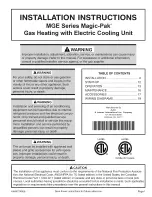
41
GAS LINE CONNECTION
1.
The water heaters covered by this manual are shipped from the
factory with 3/4 inch supply gas connections. The supply gas
line must not be smaller than 3/4 inch. Connect the supply gas
line to the water heater's 24-volt gas valve in accordance with
all applicable local and national code requirements.
2.
Depending on the developed equivalent length and/or the
number of appliances connected to a common main, the size
of the supply gas line may have to be increased, see
. If the supply gas line must be resized larger
to accommodate increased supply gas line lengths or multiple
appliances use reducer couplings and short pipe nipples to
increase the supply gas line.
Note:
Make the transition to the larger supply gas line as
close to the supply gas connection as possible.
3. Apply thread sealing compounds (pipe dope/Teflon tape)
sparingly and only to the male threads of the pipe joints. Do
not apply sealing compound to the first two threads. Use pipe
dope or Teflon
®
tape marked as being resistant to the action of
liquid petroleum (LP/propane) gases.
LOW GAS PRESSURE
SWITCH
COMBUSTION
BLOWER
SUPPLY GAS CONNECTION
FACTORY INSTALLED
TEE FITTING
Figure 55. Supply Gas Line Connection
4.
Use only a smooth jaw adjustable wrench as a back up on the
body of the 24-volt gas valve when tightening the first pipe
nipple into the body of the valve.
DO NOT
use
a standard
pipe wrench (Stillson wrench) with metal tooth jaws as this may
permanently damage the valve.
5.
Use a standard pipe wrench (Stillson wrench) as a back up
on the first pipe nipple installed above when connecting other
fittings and pipe in the supply gas line to prevent the 24-volt
gas valve on the water heater from twisting during installation.
6. To prevent damage, care must be taken not to apply too much
torque when connecting the supply gas line to the water heater.
7.
Install a sediment trap as shown in
8.
Install a Main Gas Shutoff valve in the supply gas line as shown
Note:
If overheating occurs or the gas supply fails to shut
off, turn off the Main Gas Shutoff valve to the water
heater.
GAS LINE LEAK TESTING
Any time work is done on the gas supply system perform a leak
test to avoid the possibility of fire or explosion.
Fire and Explosion Hazard
Leak test gas connections before
placing water heater in operation.
Disconnect gas piping at main
gas shutoff valve before leak
testing heater.
Install sediment trap in
accordance with NFPA 54 or
CAN/CSA B149.1.
Use joint compound or Teflon tape
compatible with propane gas.
1.
For test pressures exceeding 1/2 psi (3.45 kPa) disconnect
the water heater and its Main Gas Shutoff Valve from the gas
supply piping system during testing, see
The gas supply line must be capped when disconnected from
the water heater.
2.
For test pressures of 1/2 psi (3.45 kpa) or less, the water heater
need not be disconnected, but must be isolated from the supply
gas line by closing the Main Gas Shutoff Valve during testing.
3. Paint all supply gas line joints and connections upstream of the
water heater with a rich soap and water solution to test for leaks.
Bubbles indicate a gas leak. Do not use matches, candles, flame
or other sources of ignition for this purpose.
4.
Repair any leaks before placing the water heater in operation.
PURGING
Gas line purging is required with new piping or systems.
Purging should be performed per the current edition of
NFPA 54
the
National Fuel Gas Code
or
CAN/CSA B149.1
Natural Gas and Propane
Installation Code
.
ELECTRICAL WIRING
All electrical work must be installed in accordance with the
National
Electrical Code
,
ANSI/NFPA 70
or the
Canadian Electrical Code
,
CSA
C22.1
and local requirements.
When installed, the water heater must be electrically grounded in
accordance with local codes or, in the absence of local codes, with
the
National Electrical Code
,
ANSI/NFPA 70
or the
Canadian Electrical
Code
,
CSA
C22.1.
If any of the original wire as supplied with the water heater must
be replaced, it must be replaced with 105°C rated wiring or its
equivalent, except in the burner housing. In this case 200°C rated
wire must be used.
DEDICATED POWER WIRING AND BREAKERS
Dedicated power supply wires, neutral wires, ground wiring, and
dedicated circuit breakers often prevent electrical line noise and
are required when installing the water heater.
Note:
This water heater should not be connected to
an electrical supply with a Ground Fault Circuit
Interrupter (GFCI) or Arc Fault Circuit Interrupter
(AFCI) with Integral GFCI protection as defined in
NFPA 70
,
CSA C22.1
and
UL 943
.
Summary of Contents for SUF 60120 THRU
Page 67: ...67 WIRING DIAGRAM Figure 67 Wiring Diagram...
Page 77: ...77 NOTES...
Page 78: ...78 NOTES...
Page 79: ...79 NOTES...
















































